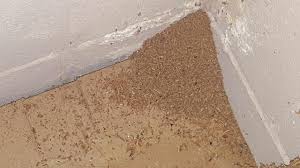Frass is the excrement of the digestive system of various pests. This material contains what the insect ate, and the term is often associated with tree-eating pests such as termites or carpenter ants. Insect pouch is a visible sign of infestation, but there are other types of insects. To the untrained eye, they may seem similar, but there are significant differences between them. Every insect has a unique method of disposal of debris, and this can also help the pest control specialist correctly identify the insect.
If you are curious about the invasion of carpenter ants or termite ants, then you can confirm it without calling professionals, by looking out for the frass of pests.
If you can distinguish between frass of different pests, then it will be easier for you to do the treatment alike.
What is Termite frass?
Drywood termites when invade, leave few signs of infestation in homes. When a pair of swarmers install a nest, they close the hole they entered and stay there for a while because they have stored everything inside the tree which will help them survive. As they reproduce and grow, they consume wood and create holes to push out the dust so that the area where their eggs are located stays clean.
The droppings of termites are oval capsules with rounded ends and six concave sides. With a length of about 1 millimetre, they can form small mounds, similar to pepper or salt, near the nest. The colour of the pellets varies depending on the wood the termites have eaten.
It is important to note that raw wood termite meal looks the same. However, these termites don’t usually target homes.
What is Carpenter ant frass?
Carpenter ants’ frass is entirely different from the litter that dry wood termites leave behind. Carpenter ants do not eat the wood they destroy. Instead, they chew the wood to create tunnels for their colonies. This activity leaves light-coloured sawdust near where they enter or leave the woods. The leaf may also look like pencil sharpening shavings that is why the frass of carpenter ant don’t have a uniform shape or size.
Carpenter ant frass vs Termite frass Identification
Insect faeces can be soft and fibrous. Pieces of wood and other debris may also be present in a mixture of this type of fraction. This is one of the primary identification points for ants infestation, as termite ants contain only faeces. It is in the shape of a granule, and these small droppings are about one millimetre in size.
They will be located near an exit hole in the forest where termites have buried themselves in the woods to build their nests. They don’t want their excrement to end up in the nests, so they push it through these holes to the other side. This termite meal is a crucial indicator of mass termite infestation and requires immediate action.
On the other hand, carpenter ants work as a unit digging through wet wood. Their first task is to make small cuts leading to the surface. This is to remove dust from their paths, which, luckily for you, makes the infestation immediately visible. Carpenter ants differ from termite ants in that the ants do not consume the wood they ingest.
The frass left by carpenter ants will contain dead insects and will resemble shavings of various lengths and shapes. Carpenter ants also usually gather around their flour, leaving it around the nest holes.
Carpenter ant frass vs Termite frass Treatment
Regardless of whether you think you have a problem with termites or carpenter ants, seeking pest control services is the only way to ensure you eradicate them all. Here is something you should also know.
- Frass itself is not considered harmful, but you should avoid handling it with yourself. You must check it with the help of a professional.
- It is very likely that when you see the droppings of carpenter ants or termite ants, you want to clean it up, but it is advised not to do this by yourself. Instead, hire a professional to help with cleaning.
- Carpenter ants do not do as much damage as termites, but their nests can do significant damage if left to grow for years.
- Baits are potent in killing the carpenter ants and termites because they can attract carpenter ants and termites, which they share with their colonies, eventually killing everyone.



